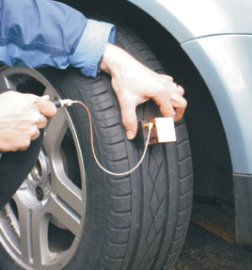Like modern doctors, magnetic resonance imaging (MRI) scanners don’t do house calls. They and related nuclear magnetic resonance (NMR) instruments for chemical analysis require that a patient or sample come to a lab or clinic and squeeze into the inner recesses of a machine.

Although a few small magnetic resonance probes exist for field applications such as checking tires’ stiffness, those sensors glean only crude information from their subjects compared with what conventional scanners can do, according to Bernhard Blümich of RWTH Aachen University in Germany. To do better, such devices would have to generate more-uniform magnetic fields.
Now, an open, or “single-sided,” sensor created by Blümich and other scientists in Germany and the United States has done just that, at least fleetingly. The researchers report in an upcoming Science that they have built a phone-book–size system that briefly projects a uniform magnetic field into a pea-size space just above the system’s trough-shaped magnet.
Although still far from making images with such a sensor, the team has demonstrated the device’s ability by using it to identify chemical signatures, or “shifts,” of fluorine compounds—a feat that requires a highly uniform magnetic field.
“It’s important because for the first time ever, one has been able to resolve chemical shifts with a single-sided apparatus,” says Carlos A. Meriles of the City University of New York, one of the team members.
Paul Callaghan of Victoria University in Wellington, New Zealand, predicts that “groups around the world working in the area of … portable NMR will find this result very influential.”
Magnetic resonance instruments excite the magnetism of atomic nuclei in a sample. Each nucleus acts as a bar magnet that aligns with a magnetic field generated by the instrument. Then, firing rapidly varying radio pulses into the sample causes the nuclei to emit their own radio waves of specific frequencies. The signals betray the identities, molecular locations, and chemical environments of atoms in the sample.
Usually, instruments need huge, expensive superconducting magnets to generate a constant, uniform field, notes Alexander Pines of the University of California, Berkeley, another collaborator on the new work.
However, in 2001, he, Meriles, and their colleagues demonstrated that well-crafted magnetic pulses could make up for the intrinsic irregularities of single-sided sensors (SN: 8/4/01, p. 73: Available to subscribers at Turning magnetic resonance inside out). Now, they and the Aachen group have incorporated those guidelines into an actual device.
Although many technical hurdles remain, the new results suggest myriad field uses for such a portable magnetic resonance sensor, the researchers say. These include detecting oil underground, resolving the composition of archaeological samples, and performing medical diagnoses.






